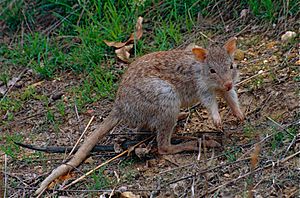Rufous rat-kangaroo facts for kids
Quick facts for kids Rufous rat-kangaroo |
|
|---|---|
 |
|
| Conservation status | |
| Scientific classification | |
 |
|
| Distribution of the rufous rat-kangaroo |
The rufous rat-kangaroo (Aepyprymnus rufescens) is also known as the rufous bettong. It is a small marsupial that lives in Australia. This animal belongs to a family called Potoroidae, which includes other rat-kangaroos and bettongs. The rufous bettong is about the same size as a full-grown rabbit. Good news! It is not considered an endangered animal.
Contents
About the Rufous Bettong
The rufous rat-kangaroo is the only animal in its group, or genus. It is also the biggest of all the potoroids. These animals are mostly grey, but they have a reddish-brown tint, especially in their fur. Their scientific name, Aepyprymnus rufescens, means "reddish high-rump."
Scientists once thought these animals lived alone and were only active at night. However, new observations show that rufous rat-kangaroos might live in loose groups. A male might even live with one or two females. They mostly eat tubers (like potatoes) and fungi (like mushrooms). They also munch on leaves and other vegetation.
What Does the Rufous Bettong Look Like?
The rufous bettong is part of the Potoroidae family. This family includes small to medium-sized marsupials like the potoroos and bettongs. The rufous bettong is the largest living animal in this group.
This animal has ruffled and bristly fur, especially on its upper body. The fur has a reddish tint. Its back is mostly grey with some reddish color and shiny silver hairs mixed in. There is a faint stripe along its hip. The fur on its belly is also grey, but lighter.
The rufous bettong's head and body together are about 38.5 to 39 centimeters (about 15 inches) long. Its tail can be 34 to 39 centimeters (about 13 to 15 inches) long. The tail is mostly grey-brown, but sometimes it has a white tip. Its ears are quite long, about 4.8 to 5.7 centimeters (about 2 inches), and shaped like triangles. The outside of the ears is very dark, while the inside is pink. Silver hairs line the edges of the ears. Around its eyes, there is a pink ring with no hair. These animals usually weigh between 2.5 and 3.5 kilograms (about 5.5 to 7.7 pounds).
A similar animal, the northern bettong (Bettongia tropica), looks different. It does not have shaggy, reddish fur. Its tail is blackish, and it does not have the hairless pink ring around its eyes or pointy triangular ears like the rufous bettong.
Rufous bettongs make different sounds. They have a soft hissing sound for an alarm call. When they are aggressive, they can make a sound like a chainsaw. During their normal activities, they often make grunting noises.
Rufous Bettong Life Cycle
Rufous bettongs can breed all year long. Females are ready to have babies when they are about 11 months old. Males are ready a bit later, between 12 and 13 months old. Once a female is mature, she can have babies about every three weeks.
A baby rufous bettong grows inside its mother for about 22 to 24 days. After it is born, the tiny baby lives in its mother's pouch for about 16 weeks. When the young bettong leaves the pouch, it stays close to its mother for about 7 more weeks. This time helps the young animal learn how to find food and take care of itself.
Rufous Bettong Behavior
Rufous bettongs might live alone, or they might share nests. Sometimes, one male will live with one or two females. They build their nests under thick plants. The nest is a shallow spot lined with woven plant material.
These animals are very active at night. They only come out after the sun sets and return to their nests before the sun rises. Their body position changes depending on what they are doing. They might stand upright on their back legs to look around. If they feel threatened, they pull their front paws to their chest and hop away quickly. When they are moving slowly to find food, they walk on all four legs and use their tail for balance.
Their favorite foods are fungi that grow underground and tubers. They have strong claws on their front paws that help them dig these foods up. They also eat some insect larvae, stems of sedge plants, grasses, and seeds. A museum collector named Charles M. Hoy once saw these animals come into his camp at night. They ate pieces of bread but did not touch the vegetable scraps!
Where the Rufous Bettong Lives
The rufous bettong can be found along the coast and near-coastal areas of eastern Australia. They live from Newcastle in New South Wales all the way up to Cooktown in Queensland. They used to live in the Murray River Valley in New South Wales and Victoria, but they are no longer found there.
Images for kids
See also
In Spanish: Canguro rata rojizo para niños




